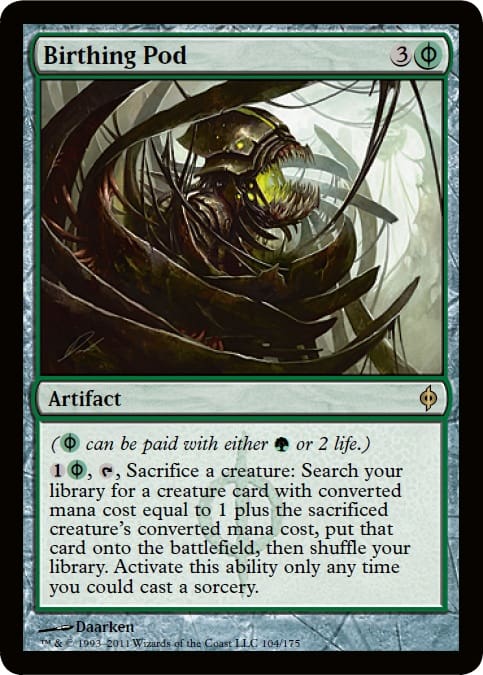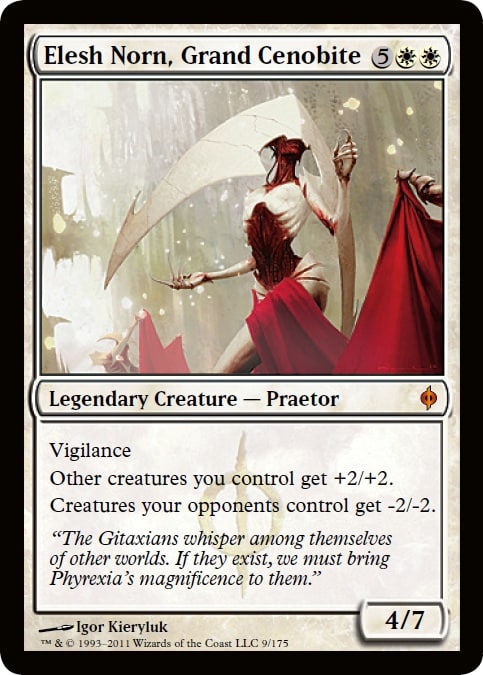I have recently been playing a lot of mono-colored, aggressive, budget decks in Standard. While I have been having decent results, I’ve decided it’s time to play something that is better at taking advantage of play skill. While play skill matters with any deck (something some people seem to forget), the decks I’ve been playing recently are very draw-dependent.
If I have a good draw with mono-red, I usually win, and if I have a bad draw, I usually lose. I’m generalizing of course, but the strategy is very straightforward, and the draws aren’t very flexible. Obviously, the better I play it, the better my results, but the deck is very draw-dependent—which brings me to Naya Pod.
With cards like Birthing Pod and Green Sun's Zenith, the deck can be flexible, giving me major decision points that will allow me to react to the game situation, and with good choices, will allow me to be able to handle those situations. The biggest key is building the deck so that it will be able to consistently provide me with the answers to the top decks in the metagame.
Before the addition of Cavern of Souls to the format, I felt that Mana Leak was among the defining cards of the Standard environment. With the addition of the Cavern to the environment, permission seems to be playing a much smaller role in the metagame. Even some Delver decks and Solar Flare decks have stopped running permission, while R/G aggro, ramp, Pod, Zombies, and tokens are taking up a fair share of the metagame without using any permission. In matchups in which I don’t have to worry about having my spells countered, the ability to search for silver-bullet cards on demand should give me a big advantage—as long as I have the right cards to search for.
The current trend is to build Naya Pod as a solid three-colored, aggressive, good-stuff deck with three Pods and a couple of one-ofs. While this is obviously a strong approach, I want to try something different for three reasons:
- A controlling version is more my style. This is even evident in Red Kastle, in which I have massive quantities of burn and relatively few cheap creatures.
- The version that is currently popular has had decent results, but it isn’t winning major tournaments. There are many possible reasons for this, but if it was winning 5Ks and/or Grands Prix, I probably wouldn’t bother to try to reinvent it.
- I want to make a version that is more specifically targeted against the current metagame.
A good example of the popular version of Naya Pod is the one piloted by Jeremy Barbeau to a second-place finish at the TCGplayer qualifier (TCQ) in Wisconsin on June 1:
"Jeremy Barbeau’s Naya Pod"
- Creatures (31)
- 1 Acidic Slime
- 1 Borderland Ranger
- 1 Daybreak Ranger
- 1 Fiend Hunter
- 1 Inferno Titan
- 1 Wolfir Silverheart
- 1 Zealous Conscripts
- 2 Restoration Angel
- 3 Blade Splicer
- 4 Avacyn's Pilgrim
- 4 Birds of Paradise
- 4 Huntmaster of the Fells
- 4 Strangleroot Geist
- 1 Phyrexian Metamorph
- 2 Thalia, Guardian of Thraben
- Planeswalkers (1)
- 1 Garruk Relentless
- Spells (4)
- 1 Oblivion Ring
- 3 Birthing Pod
- Lands (24)
- 1 Mountain
- 1 Plains
- 2 Rootbound Crag
- 3 Gavony Township
- 3 Sunpetal Grove
- 4 Copperline Gorge
- 4 Razorverge Thicket
- 6 Forest
Here is my take on Naya Pod:
"My Naya Pod"
- Creatures (24)
- 1 Acidic Slime
- 1 Blade Splicer
- 1 Borderland Ranger
- 1 Dawntreader Elk
- 1 Daybreak Ranger
- 1 Fiend Hunter
- 1 Huntmaster of the Fells
- 1 Primeval Titan
- 1 Restoration Angel
- 1 Strangleroot Geist
- 1 Viridian Emissary
- 1 Wolfir Silverheart
- 3 Avacyn's Pilgrim
- 4 Birds of Paradise
- 1 Phyrexian Metamorph
- 1 Solemn Simulacrum
- 1 Wurmcoil Engine
- 1 Elesh Norn, Grand Cenobite
- 1 Sigarda, Host of Herons
- Spells (12)
- 4 Bonfire of the Damned
- 4 Green Sun's Zenith
- 4 Birthing Pod
- Lands (24)
- 3 Mountain
- 3 Plains
- 9 Forest
- 1 Kessig Wolf Run
- 4 Copperline Gorge
- 4 Razorverge Thicket
There are several obvious differences:
- Bonfire of the Damned – Many of the most popular decks in Standard have twelve or more creatures with a toughness of 2 or less: Delver, R/G aggro, Naya Pod, Zombies, and Tokens. Having four Bonfires will help me stay alive against these decks while I’m working toward the late game. Given how much mana and mana ramping my deck has, the Bonfires can also be quite impressive in the late game.
- Green Sun’s Zenith – Given that I’m running seventeen green creatures, including twelve different types, this seems like a perfect fit. It has many of the benefits of Birthing Pod without many of the drawbacks. This way, I have eight ways to search for the right answers instead of three.
- One Versus Four – Instead of having four Huntmasters, four Geists, and three to four Splicers, I have entirely one-of creatures other than mana creatures. This is largely because I’m running the eight search cards. Jeremy’s version is often going to be faster—he will usually be using all of his mana to play creatures instead of spending time and mana searching. I’m hoping that having more search and more search options will compensate me for a little less speed.
- The High End – Jeremy’s curve tops out with one 6-drop: Inferno Titan. This goes well with his more aggressive strategy. He puts on steady pressure with Geists, Splicers, and Huntmasters, and the Inferno Titan makes an excellent finisher. I have a more control-oriented high end: Primeval Titan, Wurmcoil Engine, and Elesh Norn. Since my deck is more committed to making it to the late game, I need more powerful things to do when I get there.
- Sideboard – Jeremy’s sideboard allows him to make his creature selection more controlling, like the selection in my main deck. I have the advantage of more ways to search for one-ofs, of course. Jeremy is also more willing to play with one- and two-ofs that he can’t search for. He has one Oblivion Ring and one Garruk in his main deck. He also has seven noncreature spells in his sideboard that are either one- or two-ofs. Given that my version is focused on being able to search for creatures, all of my one- and two-ofs are creatures. I do have Oblivion Rings in my sideboard because they are such powerful and flexible control cards, but I have three of them to help make up for the fact that I can’t search for them.
The other big thing that sets my version apart from most other Naya Pod decks is that I’ve essentially built a Wolf Run Ramp deck into my Pod deck. Cards such as Viridian Emissary, Dawntreader Elk, and Solemn Simulacrum—along with 1-drop mana creatures—can help me ramp quickly up to enough mana to Zenith for my Primeval Titan, which will find me my Kessig Wolf Run.
As usual, the most popular decks in Standard appear to be Delver decks. Having four Bonfires, Elesh Norn, and Daybreak Ranger in the main deck should help me keep those creatures under control. This will be a little bit harder since they’re usually running Mana Leaks, of course. Resolving a Pod can be a big help. Searching out Sigarda will often stop the Delver team cold—she can’t be Vapor Snagged!
Playing against R/G aggro is much like playing against a Pod deck, except that it uses Zenith instead of Pod, and it has two colors instead of three. Much of the matchup may come down to how much burn the deck is using—killing my mana creatures can sometimes slow me down to a lethal extent. I hope Fiend Hunters and Bonfires can help keep opposing creatures from overwhelming me until my superior late game and life-gain can give me a decisive advantage.
This version of Naya Pod is actually among my favorite types of deck: a hybrid deck. I’ve taken many of the best elements from all of the best green decks in the format and mixed them synergistically into one deck: Pod, Ramp, and R/G aggro. Obviously, the big question is whether this is one of those occasions when playing a hybrid deck is better than just playing one of the decks it was inspired by. By the time you read this, I’ll have had the chance to test it against a challenging field at StarCityGames Open Series: Worcester, and who knows? If it does well enough there, perhaps I’ll be taking a trip to the Magic World Cup Qualifier in Maryland next week.
























